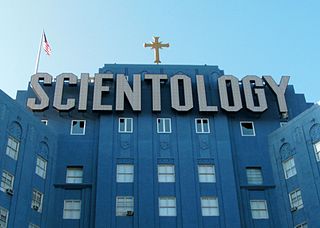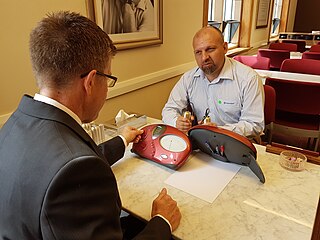
Dianetics is a set of ideas and practices, invented in 1950 by science fiction writer L. Ron Hubbard, regarding the human mind. Dianetics was originally conceived as a form of psychological treatment, but was rejected by the psychological and medical establishments as pseudoscientific. It was the precursor to Scientology and has since been incorporated into it. It involves a process referred to as "auditing", which utilizes an electrical resistance meter, ostensibly to remove emotional burdens and "cure" people from their troubles.
Narconon International is a Scientology organization which promotes the theories of founder L. Ron Hubbard regarding substance abuse treatment and addiction. Its parent company is the Association for Better Living and Education (ABLE), which is owned and controlled by the Church of Scientology. Headquartered in Hollywood, California, United States, Narconon operates several dozen residential centers worldwide, chiefly in the U.S. and western Europe. The organization was formed in 1966 by Scientologist William Benitez with Hubbard's help, and was incorporated in 1970.

Disconnection is the severance of all ties between a Scientologist and a friend, colleague, or family member deemed to be antagonistic towards Scientology. The practice of disconnection is a form of shunning. Among Scientologists, disconnection is viewed as an important method of removing obstacles to one's spiritual growth. In some circumstances, disconnection has ended marriages and separated children from their parents.

In Scientology, the concept of the thetan is similar to the concept of self, or the spirit or soul as found in several belief systems. The term is derived from the Greek letter Θ, theta, which in Scientology beliefs represents "the source of life, or life itself." In Scientology it is believed that it is the thetan, not the central nervous system, which commands the body.
In Scientology, an implant is a form of thought insertion, similar to an engram but done deliberately and with evil intent. It is "an intentional installation of fixed ideas, contra-survival to the thetan".

The Purification Rundown, also known as the Purif or the Hubbard Method, is a pseudoscientific procedure that advocates of Scientology claim is a detoxification program. There is no evidence for its efficacy in detoxification, and significant evidence from clinicians that it is dangerous. It involves heat exposure for up to 5 hours a day and can exceed 4 weeks in length. It can potentially cause heatstroke damage, which includes brain injury, heart problems, organ failure, and death. It was developed by Scientology's founder L. Ron Hubbard and used by the Church of Scientology as an introductory service. Numerous individuals have been hospitalised as a result of taking part in the process.

A Volunteer Minister (VM) is a member of Scientology sent to a disaster zone to spread the doctrine of Scientology and provide disaster relief. The program was created in the 1970s by Scientology founder L. Ron Hubbard.

In Scientology, Operating Thetan (OT) is a state of complete spiritual freedom in which one is a "willing and knowing cause over life, thought, matter, energy, space and time". The Church of Scientology offers eight "levels" of OT, each level costing thousands of US dollars. Each OT level is confidential and is not revealed to anyone beforehand. In summary, the objective of these levels is to remove "body thetans" which are "confused, disembodied souls from other planets who have attached themselves to us".

Auditing, also known as processing, is the core practice of Scientology. Scientologists believe that the role of auditing is to improve a person's abilities and to reduce or eliminate their neuroses. The Scientologist is asked questions about past events while holding two metal cylinders attached to an electrical resistance meter (galvanometer) with a dial. The term "auditing" was coined by L. Ron Hubbard in his 1950 book Dianetics: The Modern Science of Mental Health, which describes the process.

The term fair game is used to describe policies and practices carried out by the Church of Scientology towards people and groups it perceives as its enemies. Founder of Scientology L. Ron Hubbard established the policy in the 1950s in response to criticism both from within and outside his organization. Individuals or groups who are "fair game" are judged to be a threat to the Church and, according to the policy, can be punished and harassed using any and all means possible. In 1968, Hubbard officially canceled use of the term "fair game" because of negative public relations it caused, although the Church's aggressive response to criticism continued.

Dianetics: The Modern Science of Mental Health, sometimes abbreviated as DMSMH, is a book by L. Ron Hubbard describing a pseudoscientific set of ideas, Dianetics, that would later become part of Scientology. Hubbard claimed to have developed it from a combination of personal experience, basic principles of Eastern philosophy and the work of Sigmund Freud. The book is considered part of Scientology's canon. It is colloquially referred to by Scientologists as Book One. The book launched the movement, which Hubbard later characterised as a religion, in 1950. As of 2013, the Scientology organization's publishing arm, New Era Publications, sells the book in English and in 50 other languages.
In Dianetics and Scientology, Clear is a status afforded to followers by the Scientology organization, or by other Scientologists, after they complete certain activities. It is one of the major ostensible "states" practitioners strive to reach on their way up what the Scientologists call the Bridge to Total Freedom. Scientology followers are given the status of Clear when a person is deemed to be free of the influence of engrams – supposed unwanted emotions or painful traumas which Scientology claims are not readily available to the conscious mind. Scientologists believe that human beings accumulate anxieties, psychosomatic illnesses, and aberration due to receiving engrams throughout their current or past lives, and that by applying Dianetics, every single person can obtain the status of Clear.

Since the founding of the Church of Scientology in 1954 by L. Ron Hubbard, the relationship between Scientology and psychiatry has been dominated by strong opposition by the organization against the medical specialty of psychiatry and of psychology with themes relating to this opposition occurring repeatedly throughout Scientology literature and doctrine. According to the Church of Scientology, psychiatry has a long history of improper and abusive care. The group's views have been disputed, criticized, and condemned by experts in the medical and scientific community and have been a source of public controversy.

OT VIII or OT 8 is the highest current auditing level in Scientology. OT VIII is known as "Truth Revealed" and was first released to select high-ranking public Scientologists in 1988, two years after the death of Scientology's founder, L. Ron Hubbard. OT VIII is only delivered to members of the Church of Scientology in one place—aboard the organization's private cruise ship, the Freewinds. There are a few advanced auditors that are able to deliver the level to those who meet the prerequisites.

This bibliography of Scientology includes Scientology and Dianetics-related books, periodicals and other issues authored by L. Ron Hubbard and those produced by the Church of Scientology and its related organizations. Books bearing L. Ron Hubbard's name are considered texts of Scientology's canon.
The amount of material on Dianetics and Scientology is extensive, to say the least. This material is composed of books by L. Ron Hubbard ; compilations of his works; taped lectures; auditor training materials ; course packages; booklets; a large number of magazines and annuals; and video recordings of the major annual events.

Clear Body, Clear Mind is a Scientology book compiled from L. Ron Hubbard material from the 1960s, which was published posthumously in 1990 by Bridge Publications, the Church of Scientology's publishing house. The book is considered part of Scientology's canon. It is the textbook for the Purification Rundown ("Purif"), which Scientologists believe is a detoxification program with medical and spiritual benefits, but has been criticized as pseudoscientific by medical professionals who have called it "dangerous", "quackery," and "in some cases lethal".

An incident in Scientology beliefs is something that happened to a person that continues to have a grip on their mind or spirit, and is negatively affecting them. It could be an accident or traumatic event that includes pain and subconscious commands, whether from this life or in past lives. Scientology auditing procedures are used to locate incidents in the mind, and relieve them.

The beliefs and practices of Scientology include material related to sex and the rearing of children, which collectively form the second dynamic in Scientology. These beliefs and practices are based on the written works of Church of Scientology founder L. Ron Hubbard.
The Second Chance Program is a controversial detoxification and rehabilitation program based on the ideas of L. Ron Hubbard, the founder of the Church of Scientology. It focuses on individuals convicted of substance abuse offenses. The program utilizes a combination of saunas, vitamins, minerals and oils to tackle the effects of drug addiction. Other elements of the program aim to improve the educational and social abilities of inmates, and to instil a moral code for them to live by. First established in Baja California, Mexico, in 1995, Second Chance has attracted controversy over its methods and claimed success rates.
Scientology in Egypt has no official presence because non-monotheistic religions are not recognized in Egypt. The Church of Scientology has claimed that Egypt is one of the "countries in which Dianetics and Scientology services are ministered", but there are no known membership statistics available. In 2002, two Scientologists were detained by Egyptian authorities under the charges of "contempt of religion". As of 2010, books authored by Scientology founder L. Ron Hubbard and printed by the Church of Scientology for its front groups were being distributed in Egypt—even bearing the approval of Al-Azhar, the highest Sunni learning institution in the Muslim world. Narconon, an organization that promotes Hubbard's drug abuse treatment, has a branch in Ismailia Governorate called "Narconon Egypt".





